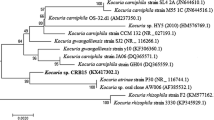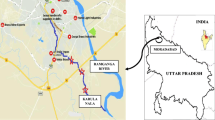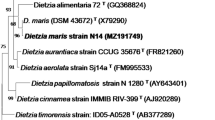Abstract
Microbial and plant assisted bioremediation is an emerging way for the remediation of soils polluted with heavy metals. To screen the cadmium tolerant bacteria, soil samples were collected from Nanjing mining area, China. The average cadmium content of the mine soil reached 45.71 mg/kg, which was indicating serious pollution and potential ecological risk. From the mine soil, six cadmium tolerant plant growth-promoting rhizobacteria (PGPR) were isolated. The isolated bacterial strain “SY-2” showed maximum cadmium tolerance and it was selected for further experimentation. This strain was identified as Stenotrophomonas maltophilia by 16S rRNA gene sequencing (GenBank accession number MG597057). SY-2 was found to tolerate maximum cadmium at 1.0 mM concentration. This strain also exhibited good adsorption capacity (up to 35.7%) of heavy metal at 0.5 mM concentration. The results of this study exhibited organic phosphorus solubilization (37.08 mg/L) and IAA biosynthesis (15.11 mg/L) ability of isolated S. maltophilia. Scanning electron microscopy (SEM) revealed cell shrinkage and the cell wall of S. maltophilia was very rough. Moreover, the energy dispersive X-ray (EDX) analysis endorsed the adsorption of Cd ions on the surface of biomass. FT-IR study described the presence of functional groups and the nature of chemical bonds, before and after cadmium stress. At 0.25 mM cadmium concentration, S. maltophilia treated seeds of Capsicum annuum L. developed 1.46 times longer roots than untreated seeds. The results of this study helped us to conclude that SY-2 strain of S. maltophilia possesses significant metal tolerance and bioremediation potential against cadmium. In the future, this strain can be used as a microbial remediation agent to detoxify heavy metals in contaminated soils.







Similar content being viewed by others
References
Afzal A, Rasool M, Waseem MH, Aslam MB (2017) Assessment of heavy metal tolerance and biosorptive potential of Klebsiella variicola isolated from industrial effluents. AMB Express 7(1):184
Ahmad F, Ahmad I, Khan MS (2008) Screening of free-living rhizospheric bacteria for their multiple plant growth promoting activities. Microbiol Res 163(2):173–181
Alkorta I, Hernandez-Allica J, Becerril JM, Amezaga I, Albizu I, Garbisu I (2004) Recent findings on the phytoremediation of soils contaminated with environmentally toxic heavy metals and metalloids such as zinc, cadmium, lead and arsenic. Rev Environ Sci Biotechnol 3:71–90
Arivalagan P, Singaraj D, Haridass V, Kaliannan T (2014) Removal of cadmium from aqueous solution by batch studies using Bacillus cereus. Ecol Eng 71:728–735
Ashraf MA, Rasool M, Mirza MS (2011) Nitrogen fixation and indole acetic acid production potential of bacteria isolated from rhizosphere of sugarcane (Saccharum officinarum L.). Adv Biol Res 6:348–355
Association of Official Analytical Chemists (AOAC) (1990) Official methods of analysis: changes in official methods of analysis made at the annual meeting, vol 15. Association of Official Analytical Chemists, Arlington
Burges A, Epelde L, Benito G, Artetxe U, Becerril JM, Garbisu C (2016) Enhancement of ecosystem services during endophyte-assisted aided phytostabilization of metal contaminated mine soil. Sci Total Environ 562:480–492
Chakravarty R, Banerjee PC (2008) Morphological changes in an acidophilic bacterium induced by heavy metals. Extremophiles 12(2):279–284
Chen YP, Rekha PD, Arun AB, Shen FT, Lai WA, Young CC (2006) Phosphate solubilizing bacteria from subtropical soil and their tricalcium phosphate solubilizing abilities. Appl Soil Ecol 34(1):33–41
Chibuike GU, Obiora SC (2014) Heavy metal polluted soils: effect on plants and bioremediation methods. Appl and Environ Soil Sci 2014:1–12
Cuypers A, Plusquin M, Remans T, Jozefczak M, Smeets K (2010) Cadmium stress : an oxidative challenge. Biometals 23:927–940
di Toppi LS, Gabbrielli R (1999) Response to cadmium in higher plants. Environ Exp Bot 41:105–130
Feng J, Shi Q, Wang X, Wei M, Yang F, Xu H (2010) Silicon supplementation ameliorated the inhibition of photosynthesis and nitrate metabolism by cadmium (Cd) toxicity in Cucumissativus L. Sci Hortic 123:521–530
Ganguly A, Guha AK, Ray L (2011) Adsorption behaviour of cadmium by Bacillus cereus M116: some physical and biochemical studies. Chem Spec Bioavailab 23(3):175–182
Gao S, Seo JS, Wang J, Keum YS, Li J, Li QX (2013) Multiple degradation pathways of phenanthrene by Stenotrophomonas maltophilia C6[J]. Int Biodeter Biodegr 79(2):98–104
Godinho A, Ramesh R, Bhosle S (2010) Bacteria from sand dunes of Goa promoting growth in eggplant. World J Agric Sci 6:555–564
Göksungur Y, Üren S, Güvenc U (2005) Biosorption of cadmium and lead ions by ethanol treated waste baker’s yeast biomass. Bioresour Technol 96:103–109
Goswami D, Vaghela H, Parmar S, Dhandhukia C, Thakker JN (2013) Whole genome sequencing and analysis of plant growth promoting potentials of Pseudomonas spp. strain OG isolated from marine water. J Plant Interact 4:281–290
Goswami D, Dhandhukia P, Patel P, Thakker JN (2014) Screening of PGPR from saline desert of Kutch: growth promotion in Arachis hypogea by Bacillus licheniformis A2. Microbiol Res 169(1):66–75
Guan Y, Shao C, Ju M (2014) Heavy metal contamination assessment and partition for industrial and mining gathering areas. Int J Env Res Pub He 11(7):286–7303
Haiyambo DH, Chimwamurombe PM, ReinholdHurek B (2015) Isolation and screening of rhizosphere bacteria from grasses in East Kavango region of Namibia for plant growth-promoting characteristics. Curr Microbiol 71:566–571
Hakanson L (1980) An ecological risk index for aquatic pollution control. A sedimentological approach. Water Res 14(8):975–1001
Haq R, Zaidi SK, Shakoori AR (1999) Cadmium resistant Enterobacter cloacae and Klebsiella sp isolated from industrial effluents and their possible role in cadmium detoxification. World J Microbiol Biotechnol 15(2):283–290
He LY, Zhang YF, Ma HY, Chen ZJ, Wang QY, Qian M, Sheng XF (2010) Characterization of copper-resistant bacteria and assessment of bacterial communities in rhizosphere soils of copper-tolerant plants. Appl Soil Ecol 44(1):49–55
Hossain MA, Hasanuzzaman M, Fujita M (2010) Upregulation of antioxidant and glyoxalase systems by exogenous glycinebetaine and proline in mung bean confer tolerance to cadmium stress. Physiol Mol Biol Plants 16:259–272
Imsande J (1998) Iron, sulfur, and chlorophyll deficiencies: a need for an integrative approach in plant physiology. Physiol Plant 103(1):139–144
Jeyasingh J, Philip L (2005) Bioremediation of chromium contaminated soil: optimization of operating parameters under laboratory conditions. J Hazard Mater 118(1):113–120
Joutey NT, Sayel H, Bahafid W, El Ghachtouli N (2015) Mechanisms of hexavalent chromium resistance and removal by microorganisms. Rev Environ Contamin Toxicol 233:45–69
Karadayi M, Gulluce M, Dogan S, Gulluce E (2016) Isolation and molecular characterization of bacteria with plant growth-promoting characteristics from magnesite mining fields in Kütahya-Turkey. J Appl Biol Sci 10(3):27–32
Khamna S, Yokota A, Peberdy JF, Lumyong S (2010) Indole-3-acetic acid production by Streptomyces spp. isolated from some Thai medicinal plant rhizosphere soils. Eurasia J Biosci 4:23–32
Kloepper JW, Schroth MN (1978) Association of in vitro antibiosis with inducibility of increased plant growth by Pseudomonas spp. (Abstr). Phytopathol 12:136
Kowalska J, Mazurek R, Gąsiorek M, Setlak M, Zaleski T, Waroszewski J (2016) Soil pollution indices conditioned by medieval metallurgical activity—a case study from Krakow (Poland). Environ Pollut 218:1023–1036
Li J, Yu H, Luan Y (2015) Meta-analysis of the copper, zinc, and cadmium absorption capacities of aquatic plants in heavy metal-polluted water. Int J Environ Res Public Health 12:14958–14973
Luo SL, Chen L, Chen JL, Xiao X, Xu TY, Wan Y, Zeng GM (2011) Analysis and characterization of cultivable heavy metal-resistant bacterial endophytes isolated from Cd-hyperaccumulator Solanum nigrum L. and their potential use for phytoremediation. Chemosphere 85(7):1130–1138
Ma Y, Prasad MNV, Rajkumar M, Freitas H (2011) Plant growth-promoting rhizobacteria and endophytes accelerate phytoremediation of metalliferous soils. Biotechnol Adv 29(2):248–258
Mahmoud E, Gizawy EE, Geries L (2014) Effect of compost extract, N2-fixing bacteria and nitrogen levels applications on soil properties and onion crop. Arch Agron Soil Sci 61:185–201
Moharrer S, Mohammadi B, Gharamohammadi RA, Yargoli M (2012) Biological synthesis of silver nanoparticles by Aspergillus flavus, isolated from soil of ahar copper mine. Indian J Sci Technol 5:2443–2444
Murphy J, Riley JP (1962) A modified single solution method for the determination of phosphate in natural waters. Anal Chim Acta 27:31–36
Naseem H, Bano A (2014) Role of plant growth-promoting rhizobacteria and their exopolysaccharide in drought tolerance of maize. J Plant Interact 9:689–701
Nevita T, Pandey P, Maheshwari DK, Sood A (2013) Interactions in rhizosphere for bioremediation of heavy metals. bacteria in agrobiology: crop productivity. Springer, Berlin, Heidelberg, pp 439–461
Pan F, Meng Q, Luo S, Shen J, Chen B, Khan KY, Japenga J, Ma X, Yang X, Feng Y (2017) Enhanced Cd extraction of oilseed rape (Brassica napus) by plant growth-promoting bacteria isolated from Cd hyperaccumulator Sedum Hance. Int J Phytorem 19(3):281–289
Park D, Yun YS, Park JM (2005) Studies on hexavalent chromium biosorption by chemically-treated biomass of Ecklonia sp. Chemosphere 60(10):1356–1364
Piotrowska-Seget Z, Cycoń M, Kozdroj J (2005) Metal-tolerant bacteria occurring in heavily polluted soil and mine spoil. Appl Soil Ecol 28(3):237–246
Raja CE, Anbazhagan K, Selvam GS (2006) Isolation and characterization of a metal-resistant Pseudomonas aeruginosa strain. World J Microbiol Biotechnol 22:577–585
Ramachandran K, Srinivasan V, Hamza S, Anandaraj M (2007) Phosphate solubilizing bacteria isolated from the rhizosphere soil and its growth promotion on black pepper (Piper nigrum L.) cuttings. In: First international meeting on microbial phosphate solubilization. Springer, Dordrecht, pp 325–331
Ramyakrishna K, Sudhamani M (2016) The metal binding potential of a dairy isolate. J Water Reuse Desalin 7(4):429–441
Saleemi M, Kiani MZ, Sultan T, Khalid A, Mahmood S (2017) Integrated effect of plant growth-promoting rhizobacteria and phosphate-solubilizing microorganisms on growth of wheat (Triticum aestivum L.) under rainfed condition. Agric Food Secur 6(1):1–8
Selvi AT, Anjugam E, Devi RA, Madhan B, Kannappan S, Chandrasekaran B (2012) Isolation and characterization of bacteria from tannery effluent treatment plant and their tolerance to heavy metals and antibiotics. Asian J Exp Biol Sci 3:34–41
Siñeriz ML, Kothe E, Abate CM (2009) Cadmium biosorption by Streptomyces sp. F4 isolated from former uranium mine. J Basic Microbiol 49(S1):S55–S62
Sinha SN, Paul D (2014) Heavy metal tolerance and accumulation by bacterial strains isolated from wastewater. J Chem Biol Phy Sci 4:812–817
Tan S, Yi Y, Wang H, Zhou X, Tan Z, Liu Q (2015) Screening, identification and growth-promoting effects of ramie-promoting bacteria. Bull Microbiol 42(3):525–533
Ullah A, Heng S, Munis MFH, Fahad S (2015) Yang X (2015) Phytoremediation of heavy metals assisted by plant growth promoting (PGP) bacteria: a review. J Environ Exp Bot 117:28–40
Vashishth A, Khanna S (2015) Toxic heavy metals tolerance in bacterial isolates based on their inducible mechanism. Int J Novel Res Life Sci 2:34–41
Velásquez L, Dussan J (2009) Biosorption and bioaccumulation of heavy metals on dead and living biomass of Bacillus sphaericus. J Hazard Mater 167:713–716
Vicene CS, Nascimento F, Espada M, Barbosa P, Mota M, Glick BR, Oliveira S (2012) Characterization of bacteria associated with pinewood nematode Bursaphelenchus xylophilus. PLoS ONE 7:e46661
Wang S, Ouyang L, Ju X, Zhang L, Zhang Q, Li Y (2014) Survey of plant drought-resistance promoting bacteria from Populus euphratica tree living in arid area. Indian J Microbiol 54:419–426
Wani PA, Khan MS, Zaidi A (2007) Cadmium, chromium and copper in green gram plants. Agron Sustain Deve 27:145–153
Wierzba S (2015) Biosorption of lead (II), zinc (II) and nickel (II) from industrial wastewater by Stenotrophomonas maltophilia and Bacillus subtilis. Pol J Chem Technol 17(1):79–87
Wright MH, Adelskov J, Greene AC (2017) Bacterial DNA extraction using individual enzymes and phenol/chloroform separation. J Microbiol Boil Educ 18(2):18
Wu CH, Wood TK, Mulchandani A, Chen W (2006) Engineering plant–microbe symbiosis for rhizoremediation of heavy metals. Appl Environ Microbiol 72(2):1129–1134
Acknowledgements
The authors are highly thankful to the Instrumental Analysis Center of Shanghai Jiao Tong University for analyzing the heavy metal concentration, SEM-EDX and FT-IR.
Funding
Supported by research fund of Shanghai Landscape Architecture Construction Co., Ltd.
Author information
Authors and Affiliations
Contributions
LQL designed the experiments and supervised the research work. LJK executed the experiments. FL analyzed the data and wrote the manuscript. MFHM supervised manuscript write up and submission. UH collected samples, SA did data compilation and CSQ supervised the research work. All authors read and approved the final manuscript.
Corresponding author
Ethics declarations
Competing interests
The authors declare that they have no competing interests.
Ethical approval
This article does not contain any studies with human participants or animals performed by any of the authors.
Accession number
MG597057 (Stenotrophomonas maltophilia).
Electronic supplementary material
Below is the link to the electronic supplementary material.
Rights and permissions
About this article
Cite this article
Liaquat, F., Munis, M.F.H., Arif, S. et al. Cd-tolerant SY-2 strain of Stenotrophomonas maltophilia: a potential PGPR, isolated from the Nanjing mining area in China. 3 Biotech 10, 519 (2020). https://doi.org/10.1007/s13205-020-02524-7
Received:
Accepted:
Published:
DOI: https://doi.org/10.1007/s13205-020-02524-7




